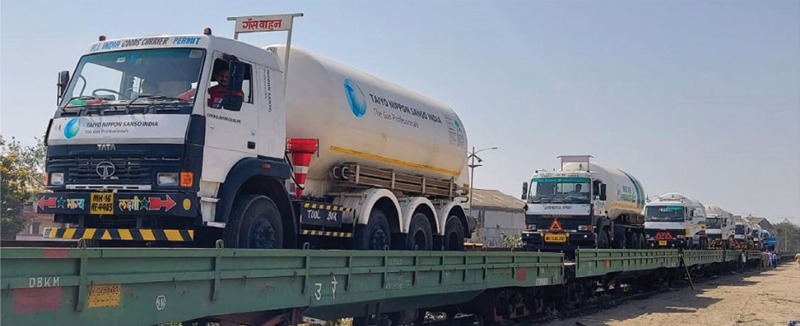
Severe Shortage of Medical Oxygen
A severe shortage of medical oxygen was experienced by hospitals in the Indian states that were severely hit by the second wave of the COVID-19 pandemic. It also led to the loss of several precious lives. India has a sufficient supply of medical oxygen however, the unavailability of containers and tankers was the culprit behind the severe scarcity.
Within 24 hours, the oxygen Expresses of Indian Railways transported Liquid Medical Oxygen (LMO) tankers with over 150 tonnes of oxygen across the country amidst the severe shortage of medical oxygen in different parts of India. A total of 10 containers having nearly 150 tonnes of oxygen have been carried so far,” said the official press release by the Ministry of Railways.
The Oxygen Express by the Indian Railways
Railways ran the first oxygen express from Kalamboli in Maharashtra to Vizag in Andhra Pradesh and then back to Nasik in Maharashtra. With a distance of more than 1850 km between Kalamboli and Vizag, the railways were able to move the oxygen tankers within 50 hours.
To enable the smooth movement of oxygen supply, Indian Railways created ramps at stipulated places so that the liquid medical oxygen tankers could be moved easily. Seven tankers with more than 100 tonnes LMO were loaded in 10 hours and transported back to Nagpur within a short span of 21 hours.
“For the movement of Ro-Ro service, Railways had to map the entire route considering the various constraints like ghat sections, the road over bridges, tunnels, curves, platform canopies, overhead equipment, etc. at certain locations. Because height is an important aspect of this movement, Railways mapped the route via Vasai. The model of road tanker T1618 with a height of 3320 mm was found feasible to be placed on flat wagons. The longer route via Vasai was charted as Over Dimensional Cargo (ODC) is not permitted to travel in ghat sections over Mumbai division,” explained the official release by the Railway Ministry.
Severely affected states like Andhra Pradesh and Delhi had requested the Railways to operate more Oxygen Express trains. Liquid Medical Oxygen is filled in tankers at Visakhapatnam and Bokaro were transported through the Ro-Ro service of Indian Railways.
Indian Government Moves into Action
The Indian Prime Minister, Narendra Modi, chaired a high-level meeting to review steps taken to boost oxygen availability across the country. PM Modi emphasized the need for all ministries and departments to work in tandem to ensure the seamless supply of critical oxygen and medical supplies.
The Ministry of Finance announced, “The government of India has taken many measures in the last few days to improve the supply of oxygen and medical supplies. IAF planes are bringing in cryogenic oxygen tanks from Singapore. IAF is also transporting oxygen tanks in the country to reduce travel times.”
Green Corridor
As the Indian state of Uttar Pradesh also had a dire need to fulfill the requirements of medical oxygen in Uttar Pradesh, a green corridor was created between Lucknow to Varanasi for the movement of the train. The distance of 270 kilometers was covered by the train in 4 hours 20 minutes with an average speed of 62.35 km per hour.
Oxygen being cryogenic and hazardous, Indian Railways had to be extra cautious while transporting this vital lifesaving commodity. It is critical to avoid sudden acceleration or deceleration. To make sure that the movement happens without any incidents, the pressure had to be monitored at regular intervals, especially when the containers were filled and loaded.
Having taken it up as a challenge to be met during this dark hour in modern Indian history, the Indian Railway made meticulous preparations. For this purpose, the entire route was mapped, people were trained to transport the special tankers to the route that traversed through Vizag, Vasai, Nagpur, Bhusaval, and Surat.
The movement of oxygen over long distances is much better through trains as it can move much faster than road transport. While it can take up to three days by road, transportation through rail takes just two days. The time difference is because trains can run nonstop through the day and night while truck drivers need to take halts for rest and refreshment along the route.
Source: www.itIn.in